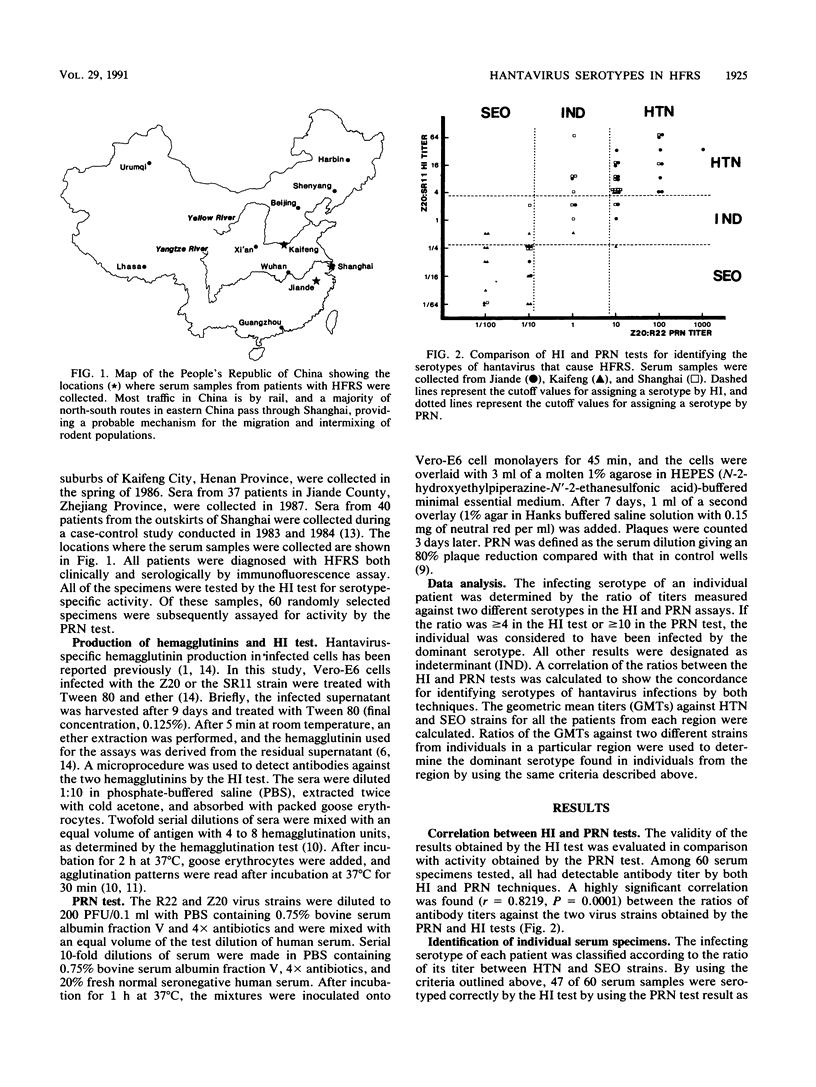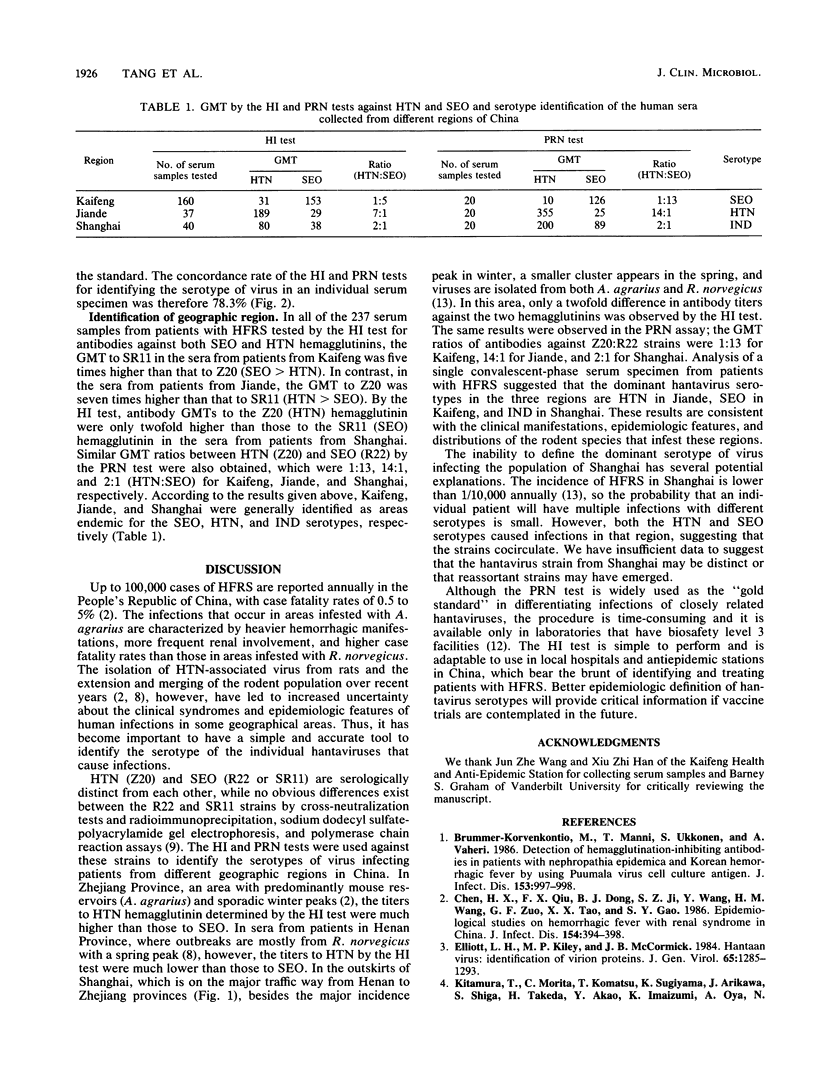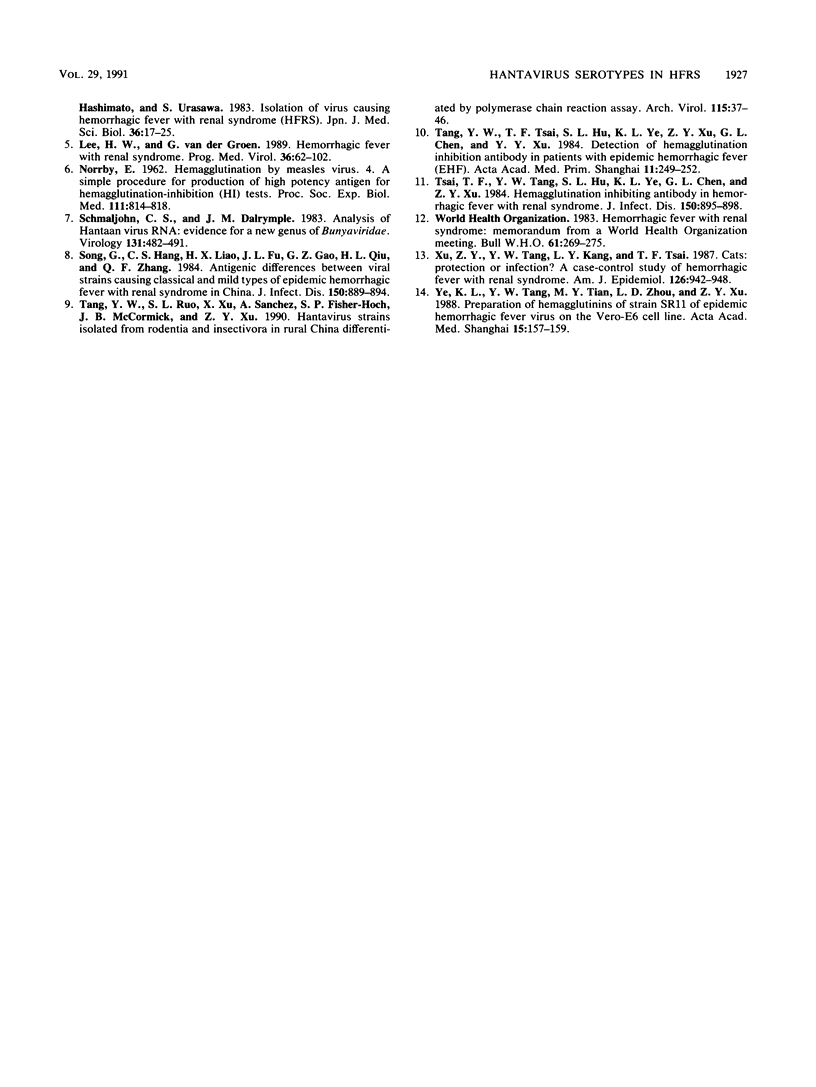Abstract
An epidemiologic evaluation of patients with hemorrhagic fever with renal syndrome from different locations in the People's Republic of China was conducted to define the prevalence of two Hantavirus serotypes, Seoul (SEO) and Hantaan (HTN). Serum specimens were collected between 5 and 14 days after the onset of illness and were tested for antibodies by both hemagglutination inhibition (HI) and plaque reduction neutralization (PRN). By the HI test, the geometric mean titer (GMT) of antibodies to SEO in the sera from individuals from Kaifeng City of Henan Province was five times higher than that to HTN. In contrast, by the HI test, the sera from individuals from Jiande County of Zhejiang Province had a GMT of antibodies to HTN that was seven times higher than that to SEO. In the sera from individuals from Shanghai, only a twofold difference was observed in HI antibody titers to the two hemagglutinins by the HI test, with that to HTN being higher than that to SEO. By the PRN test, the GMT ratios of antibody between HTN and SEO strains from individuals in Kaifeng, Jiande, and Shanghai were found to be 1:13, 14:1, and 2:1 respectively. A close correlation (r = 0.8219) and concordance rate (78.3%) were observed between the PRN and HI tests for the identification of the serotypes of individual cases of hemorrhagic fever with renal syndrome. The hantavirus serotypes from individuals in Kaifeng and Jiande were identified as predominantly SEO and HTN, respectively, and those from individuals in Shanghai had an indeterminant serotype defined by these two techniques. The HI test appears to be a simple and reliable way of determining the predominant hantavirus that causes HFRS in a given geographic area.
Full text
PDF



Selected References
These references are in PubMed. This may not be the complete list of references from this article.
- Brummer-Korvenkontio M., Manni T., Ukkonen S., Vaheri A. Detection of hemagglutination-inhibiting antibodies in patients with nephropathia epidemica and Korean hemorrhagic fever by using Puumala virus cell culture antigen. J Infect Dis. 1986 May;153(5):997–998. doi: 10.1093/infdis/153.5.997-a. [DOI] [PubMed] [Google Scholar]
- Chen H. X., Qiu F. X., Dong B. J., Ji S. Z., Li Y. T., Wang Y., Wang H. M., Zuo G. F., Tao X. X., Gao S. Y. Epidemiological studies on hemorrhagic fever with renal syndrome in China. J Infect Dis. 1986 Sep;154(3):394–398. doi: 10.1093/infdis/154.3.394. [DOI] [PubMed] [Google Scholar]
- Elliott L. H., Kiley M. P., McCormick J. B. Hantaan virus: identification of virion proteins. J Gen Virol. 1984 Aug;65(Pt 8):1285–1293. doi: 10.1099/0022-1317-65-8-1285. [DOI] [PubMed] [Google Scholar]
- Kitamura T., Morita C., Komatsu T., Sugiyama K., Arikawa J., Shiga S., Takeda H., Akao Y., Imaizumi K., Oya A. Isolation of virus causing hemorrhagic fever with renal syndrome (HFRS) through a cell culture system. Jpn J Med Sci Biol. 1983 Feb;36(1):17–25. doi: 10.7883/yoken1952.36.17. [DOI] [PubMed] [Google Scholar]
- Lee H. W., van der Groen G. Hemorrhagic fever with renal syndrome. Prog Med Virol. 1989;36:62–102. [PubMed] [Google Scholar]
- NORRBY E. Hemagglutination by measles virus. 4. A simple procedure for production of high potency antigen for hemagglutination-inhibition (HI) tests. Proc Soc Exp Biol Med. 1962 Dec;111:814–818. doi: 10.3181/00379727-111-27930. [DOI] [PubMed] [Google Scholar]
- Schmaljohn C. S., Dalrymple J. M. Analysis of Hantaan virus RNA: evidence for a new genus of bunyaviridae. Virology. 1983 Dec;131(2):482–491. doi: 10.1016/0042-6822(83)90514-7. [DOI] [PubMed] [Google Scholar]
- Song G., Hang C. S., Liao H. X., Fu J. L., Gao G. Z., Qiu H. L., Zhang Q. F. Antigenic difference between viral strains causing classical and mild types of epidemic hemorrhagic fever with renal syndrome in China. J Infect Dis. 1984 Dec;150(6):889–894. doi: 10.1093/infdis/150.6.889. [DOI] [PubMed] [Google Scholar]
- Tang Y. W., Ruo S. L., Xu X., Sanchez A., Fisher-Hoch S. P., McCormick J. B., Xu Z. Y. Hantavirus strains isolated from rodentia and insectivora in rural China differentiated by polymerase chain reaction assay. Arch Virol. 1990;115(1-2):37–46. doi: 10.1007/BF01310621. [DOI] [PubMed] [Google Scholar]
- Tsai T. F., Tang Y. W., Hu S. L., Ye K. L., Chen G. L., Xu Z. Y. Hemagglutination-inhibiting antibody in hemorrhagic fever with renal syndrome. J Infect Dis. 1984 Dec;150(6):895–898. doi: 10.1093/infdis/150.6.895. [DOI] [PubMed] [Google Scholar]
- Xu Z. Y., Tang Y. W., Kan L. Y., Tsai T. F. Cats--source of protection or infection? A case-control study of hemorrhagic fever with renal syndrome. Am J Epidemiol. 1987 Nov;126(5):942–948. doi: 10.1093/oxfordjournals.aje.a114732. [DOI] [PubMed] [Google Scholar]


